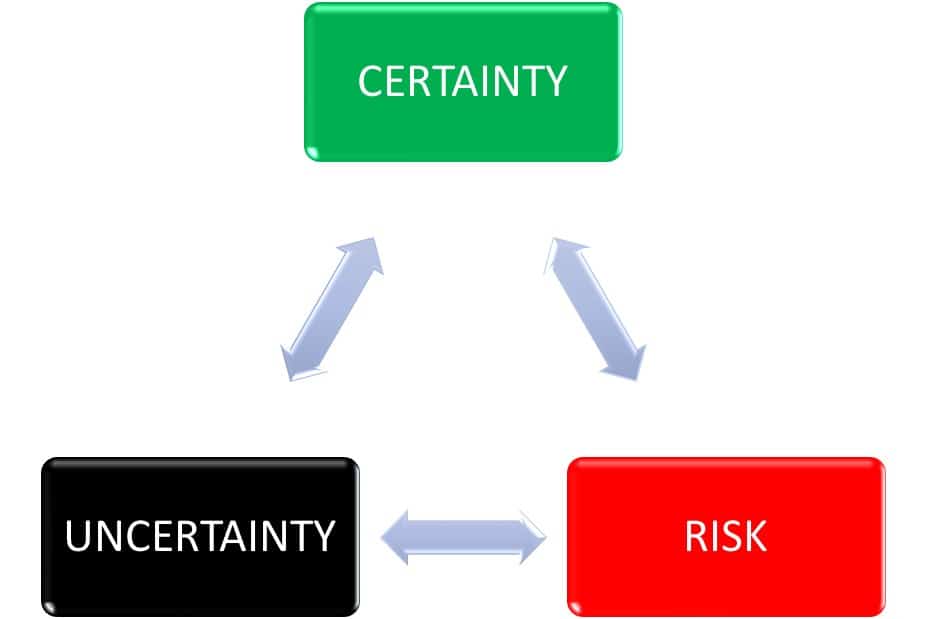Decision-making is one of the most precious assets of a manager. It’s amongst the main ingredients that help businesses move in the right direction and play the most significant part in dictating an organization’s success or failure.
Decision-making is a whole process, and managers have to go through specific steps to make effective decisions. There are many factors that influence decision-making, one of which is the environment in which a decision is made.
Every decision-making environment has its characteristics and is associated with certain pros and cons. Some environments pose more risk to decision-making than others and hence need a different strategy to handle.
In this article, I’ll explain everything about the different types of decision-making environments and how they play a key role in making decisions. Also, we’ll compare different decision environments near the end and decide which one is the riskiest.
What Is Decision Making Environment?
Whenever you’re assigned a managerial role in an organization, or you’re someone who has a team working under his command, it’ll be quite usual for you to be making multiple decisions every day.
While making such decisions, various factors need analysis before you arrive at a reasonable decision. Amongst all the factors, one such variable is the environment in which you make the decision.
A decision environment is defined by the information available, knowledge of the situation, nature of the problem, and whether there’s a certainty, uncertainty, or risk to which the decision is made under.
It’s an essential part of the whole process since it helps you decide what steps to follow and what precautions to take. Moreover, it lets us analyze the difficulty of the situation.
Highly Recommended Next Articles to Read:
13 Reasons Why Data is Important in Decision-Making
10 Reasons Why Decision-Making is Important in Management
Decision-Making Models Explained In Plain Terms
Why Are Decision-Making Environments Important?
Decision-making environments are important because they help us generalize the scenarios we face. Even though we face new situations every time we need to decide something, if we take a look at it broadly, there are only a few types of environments and every situation will eventually be falling into either of those types.
So, if we analyze every environment keenly and devise strategies for tackling their situations beforehand, it’ll help us a lot in making more effective decisions within a short period.
Types of Decision-Making Environments
Now, let’s look at the different types of decision-making environments that you could run into. While going through each type, I’ll also be explaining its significance and how it could affect the organization.
There are three types of Decision Making Environments:
- Certainty
- Uncertainty
- Risk

1. Decision-Making Under Certainty
Coming on top, we have certainty. This is often regarded as the safest decision-making environment and, consequently, the least risky. There aren’t many possibilities or paths to pursue when you’re faced with decisions in such an environment. All the data you need is readily available, or even if you need to gather it, it won’t be much expensive to get. The variables are all clear, and there are no hidden factors that could endanger your decision.
For example, consider you’re a manager and need to make a decision based on certain factors; In the case of certainty, you will have all the alternatives completely sorted out, and there won’t be much to worry about. The analysis of all the possible decisions would be done, and there would be no hidden variables. As a result, the right decision would be quite easy to distinguish from the rest.
Certainty lets you put more focus on what’s right and avoid wasting time on other alternatives. You don’t waste time thinking about different scenarios. Such scenarios are heaven for managers, and they don’t take long to get done with decisions in such environments.
2. Decision-Making Under Uncertainty
As you might have guessed, this is quite the opposite of the previous type of environment we looked at. Uncertainty is when a manager fails to get enough information needed to make a sound decision, or even if he does, it’s corrupted, biased, or has unreliable sources.
This decision-making environment is a nightmare for managers. Not only does it get very confusing about what path to follow, but when you start thinking in a certain direction, other possibilities start clouding over its authenticity and seeming more appropriate.
The variables and the data available are not credible; they keep changing and hence making the decision-maker panic. Such situations need the managers to be able to handle pressure and make the best out of any situation. A combination of a proactive approach with effective stress-management is required.
Let’s consider an example;
Consider you’re a football team coach. There are two players of your team playing on the field. By the end of the match, you need to kick one of them out. However, the problem is, both are playing at the best of their abilities, and it’s hard to separate them.
One of playing better in an instant, and the next minute, the other one exceeds him. Since their performance isn’t following a certain trend or pattern, it gets tough for you to choose which one to kick and which one to keep.
This type of decision-making environment is referred to as uncertain since a lot is going on, which leads to nothing but confusion.
3. Decision-Making Under Risk
The last type of decision-making environment is risky environments. Risk environments are when the probability of multiple events is tied to a decision. You’re never sure about the outcomes of your decision other than calculated guesses. Such decisions are associated with events that could either be very successful or quite disastrous for the organization.
When you’re faced with such problems, you will have some data available related to the situation, but it’s all a game of probabilities. The past experiences of managers play a huge role, and they often have to take a good look at their past when confronted with such decisions.
The best course of action to take in risky environments is first analyzing the risk of all the alternative actions based on the information available to you.
Once you have done the risk calculation for all the possible alternatives, choose the one with the smallest amount of risk involved.
Nowadays, almost every decision made in huge organizations is based on risk factors. This is the reason why there are whole departments dedicated to risk management. Moreover, hundreds of tools are available that help you with risk calculation if you have enough information, which makes it relatively more manageable than it would’ve been otherwise.
Which Decision-Making Environment is the Riskiest?

So, coming to the real deal, which decision-making environment is the riskiest? What type of environment poses the greatest threat to your decision-making capabilities? Well, let’s see.
First off, it’s pretty evident that certainty is out of the equation when it comes to the riskiest decision-making environments.
As we’ve seen, certainty doesn’t need a lot of pondering over the possible decisions, and mostly the decision-maker ends up being right. There are pretty rare chances someone could make a wrong decision in this environment.
So, we’re left with two environments: risk and uncertainty. Both include quite a bit of confusion, and most of the real-life scenarios are based upon them. The data and information available are mostly irregular or incomplete, and managers need to have adequate experience while dealing with such situations.
When we talk about decision making under risk, there are probabilities associated with each alternative, and one could use the calculations to be confident about the decision being made. However, there’s no such concept in uncertain environments. No matter what you do and which approach you follow, things always look blurry, and it doesn’t take much to fall into the wrong pit.
So, it’s much easier to make decisions under risk or in risky environments than in uncertain environments. Hence, uncertainty comes out on top as the riskiest environment to make decisions, and there should be appropriate steps and precautions taken when faced with such situations.
Let me give you some real life example of these two types of decision-making environments:
Imagine that you are about to open a shop or a new branch of your business in a new location and there’s no information about that location online, or in nearby registries. You are the decision-maker, and so far you’ve only heard rumors that it’s a high potential location.
a) Do you decide for opening that branch without prospecting it or not? Will it bring good revenue? (If you do it right away, there’s a lot of uncertainty here and your decision is likely to backfire)
b) You send someone to prospect the area and gather as much information as possible. After that, it comes to light that there are logistic challenges, due to road access, in the rainy season, goods deliveries cost higher. (If you decide to go ahead, at least now you know what Risk you need to mitigate and you’re better equipped to deal with it and succeed)
-
The Decision-Making Model Explained (In Plain Terms)

Any form of the systematic decision-making process is better enhanced with data. But making sense of big data or even small data analysis when venturing into a decision-making process might
-
Will Algorithms Erode our Decision-Making Skills?

Have you ever clicked on an Ad and bought something that you saw in your Social Media Newsfeed? Or, watched a video on YouTube just because it was in the
-
13 Reasons Why Data Is Important in Decision Making

Data is important in decision making process, and that is the new golden rule in the business world. Businesses are always trying to find the balance of cutting costs while
Takeaway
In addition to many other variables that decision-making needs to consider, one of the most important ones is called the ‘environment’ in which a decision is made.
Throughout the article, we’ve gone through three different types of decision-making environments and how to deal with them if you ever face them in your life. Each one of them has different levels of complexities and come with their own set of features.
Lastly, we also compared the environments to each other and, upon enough investigation, found out that uncertain decision-making environments are the hardest to deal with and undoubtedly are the riskiest ones to make decisions in.
The environment highly affects the quality of decisions made and forces us to make different types of decisions. How you as a leader use the information available and resources to make better decisions is the difference between success and failure.
